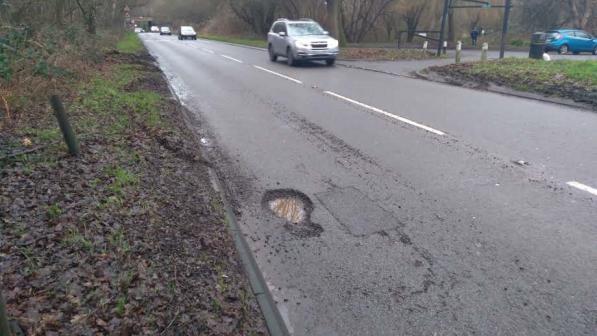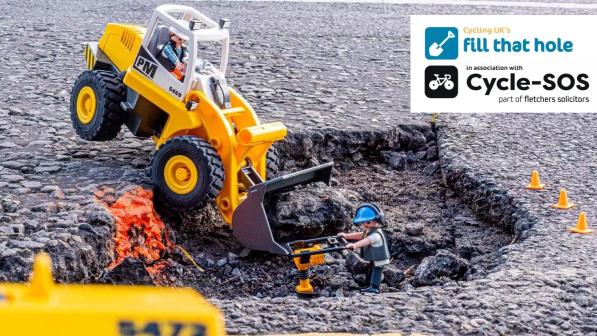The One Show pothole wars: Why cyclists need potholes to be fixed

Due to lack of investment in keeping our roads in a safe state, every year Cycling UK helps around 6,000 of our members after they have been injured after cycling over potholes. This service is provided thanks to the free legal advice members are able to access when they join Cycling UK.
If you are driver and hit a pothole you might need an expensive trip to the mechanic, but if you are a cyclist it could be much worse, and end up with a trip to the hospital.
That's the reason why over a decade ago, we set up the pothole reporting website Fillthathole to help local authorities find and fix potholes faster - so that fewer cyclists get hurt.
FillThatHole website
Since it was launched in 2007, over 150,000 potholes and road defects have been reported on the FillThatHole website. Think of this tool as a free road inspection service for cash strapped local authorities and you wouldn't be far wrong, as FillThatHole helps locate road defects on routes they might not survey regularly. In doing so, our reporting tool is helping councils save money as there is less need to survey all the roads, and more importantly it helps them save lives as dangerous road defects are subsequently fixed.
In the event of an accident where injury or damage to personal property has occurred, it can also help all road users should they wish to make a claim against the responsible highway authority for not fulfilling its duty to keep the highways in good repair.
The One Show test
Along with Vince Craig, AA’s Patrol Man of the Year and Keith Jones, Director of the Civil Engineering Institute of Wales we were invited to visit Blyton Park Driving Centre in Lincolnshire, where the race track was full of potholes. We were asked to rate the repairs on the same size potholes by three different methods. The three machines were Multihog, Nuphalt and Velocity Patcher.
It was one off, non-scientific test of three potholes measuring 3ft by 2ft.
- Multihog took 13 minutes and had a rough cost of £16.
- Nuphalt state it costs roughly £27 per repair, and took 24 minutes.
- Velocity Patcher took 8 minutes for £12.
All the machines were impressive and appeared to fix the pothole to a smooth state that I would be happy to cycle over. However, according to the rules of the One Show test there could be only be one winner and that was Velocity Patcher, as it could fix around 200 potholes a day and wasn't as expensive as the Nuphalt. Keith Jones from the Civil Engineering Institute explained that it was a good fix, that would actually improve as more vehicles drove over it.
It was close between Velocity Patcher and the Nuphalt, as Nuphalt offered a really smooth and tidy surface and looked very neat. Although it was the only machine that dug a bigger hole to check for underlying problems, the Multihog took many vehicles and by the end of the test the repaired pothole looked like it had slightly cracked around the edges, which in a real life scenario could let water in.
How Cycling UK wants the roads to be fixed
The problem with The One Show test was we weren't told how long the fixed pothole would last. Ideally we would go back in a year and see how the different methods have lasted on a road which is regularly used. Just filling in a pothole is a short term solution, if there are underlying problems it does not solve the issue. Often on the FillThatHole website the same area is reported, then fixed, only to be reported again within a year in the same place. A way to stop this happening is for planned road maintenance which will resolve the underlying problems - but that is a more expensive option that also takes time.
Cycling UK believes planned road maintenance is the way forward, as the problems are prevented before they grow out of hand.Victoria Hazael, Cycling UK Senior Communications Officer
The Government's own advice to authorities is that prevention is better than cure, a philosophy Cycling UK subscribes to. We believe planned road maintenance is the way forward, as not only are the problems prevented before they grow out of hand, but it is also the opportunity for highway authorities to reconsider their road layout and how it can be improved for cycling and walking.
We also want to see national standards for pothole fixing across the UK that establish both a dimension for intervention and proper risk assessment of the danger the defect presents. Currently it's a bit of postcode lottery as the official size of pothole that needs fixing varies and not all authorities use a risk based approach.
It's important that highways authorities do properly assess the risk a road defect has, as the dangers of a pothole are not solely dependent on its size, but also its location in the road. For instance, a minor defect on a flat road might not be a problem, but at the bottom of a descent or at the point of a junction it can be a totally different matter.
The problem is lack of funding
The Local Government Association estimated that it will take £12 billion of investment and 10 years to get all our roads in a safe and acceptable state. Local authorities repeated tell us they are struggling to find the funds to fix pothole as the National Government has not set aside enough funding, with only £6 billion allocated up till 2021.
The Government has currently set aside £15 billion for its Road Investment Strategy, which is largely allocated towards the building of new roads. Cycling UK disagrees with this policy, believing Government should adopt a "fix it first" policy – meaning the current road network should be fixed as a priority before considering building new roads. Cycling UK's policy on potholes is explained in briefing on Highway Maintenance.
What cyclists can do
- Don’t cycle in the gutter.
- Give yourself plenty of room from the side of the road.
- Avoid cycling through puddles and piles of leaves as they could be covering up potholes.
- Report potholes and road defects on the FillThatHole website.
What drivers can do
- The Highway Code recommends to give cyclists as much space as you would another car when you are overtaking. At least the width of a car and more if it’s wet and windy.
- Be patient when you see cyclists weaving around as chances are they are just trying to avoid potholes and other road defects like a slippery drain cover, glass or leaves.
- Report potholes and road defects on the FillThatHole website.




